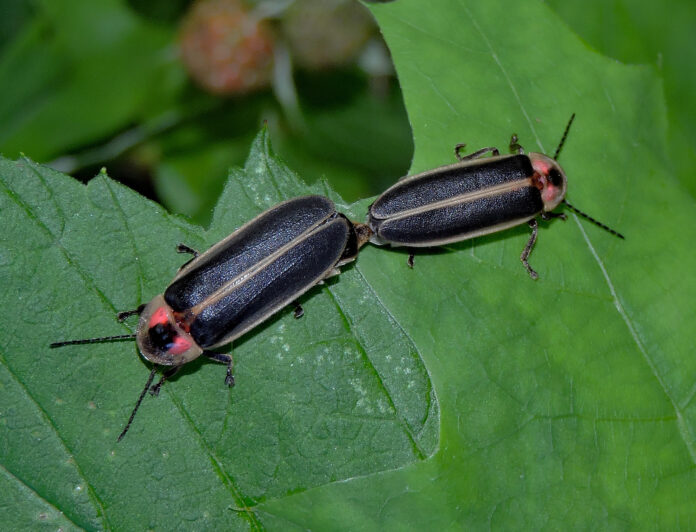They say it’s a matter of geography. People in the South and Midwest call them lightning bugs. Those in New England and the West call them fireflies.
Growing up in Ohio, summer nights were spent with a jar in one hand, while deftly nabbing lightning bugs out of the air with the other. I was pretty darn good at it too. An evening of vigorous catching usually yielded about 50 insects.
My mom always let me set the jar on the nightstand beside my bed. It was amazing how much light that many glowing bugs in one location could emit. One night, I thought it would be fun to unscrew the lid and release them into my room. Needless to say, it did not go over well.
Lightning bugs and fireflies
The names “firefly” and “lightning bug” can be used interchangeably because they are the same entity. Yet interestingly, they are neither a fly nor a bug.
Flies belong to the order Diptera, while bugs belong to the order Hemiptera. Lightning bugs are actually beetles belonging to the order Coleoptera.
A distinguishing characteristic of insects in this order is the hard outer wing coverings. When a lightning bug prepares for flight, it first lifts these coverings to release the delicate wings that are folded beneath, allowing for liftoff to occur.
Within the order of beetles, fireflies belong to the family Lampyridae. Insects in this order have soft bodies, flattened head shields and light-producing organs either in the larval or adult stage or both. It is this final characteristic that gives the insect its name and draws fascination from all who witness it.
Bioluminescence (“bio” = living, “lumin” = light) is a chemical reaction that occurs within an organism that results in the production and emission of light. Most often recognized in marine creatures, this phenomenon also occurs in fungi as well as insects.
Firefly bioluminescence results from a complex chemical reaction involving a compound called luciferin and the enzyme luciferase in the presence of oxygen. This is unique because it produces light without heat.
Worldwide, there are over 2000 species of lightning bugs. They are found on every continent except Antarctica. Here in the U.S., the majority are found in the eastern half of the country.
In Ohio, we have around 24 different species. I can take a walk down my driveway in early July as darkness is setting in and easily see 8-10 species without any effort. How can I tell them apart? Each species has its own unique display. This includes flash pattern, flash color and height above the ground.
Identifying different types
The most common species in the genus Photinus lights up about 2 feet above the vegetation. Holding its vivid yellow light on, it dips downward into the grass, and then pops back up, forming the letter ‘J,’ earning it the nickname “Big Dipper.”
Another species displays at about 8 feet up. While moving in a straight line, it blinks one-two-three, pauses a few seconds, and continues across the field blinking a much whiter light, one-two-three, one-two-three.
Just inside the wood edge, another species with an orange light blinks at about 3 feet above the ground. This happens so quickly that you must watch intently or you might miss it.
Yet another, fast traveler at about 12 feet up, holds its light on for several seconds creating a long, bright streak. These “streakers” remind me of meteors.
Mating
The main reason that fireflies blink is their desire to find a mate. Males, who do their blinking while in flight, keep an eye out for responding females that are hiding within the vegetation. Once located, a male and female will blink their own unique flash pattern back and forth to each other, while the male draws closer and closer. Finally, the two unite and tie the knot.
But things aren’t always that romantic. Although most species feed on pollen and nectar, females in the genus Photuris have developed an incredible way to obtain their meal. Imitating the flash patterns of other female species, they deceptively draw in a male, only to pounce on and devour him. Life and death situations such as these occur throughout the night and throughout the season.
Lightning bugs have a complete life cycle which includes egg, larvae, pupa and adult. After mating has occurred, the female deposits around 100 eggs near the surface of moist soil, under leaf litter or on vegetation. After a period of 3-4 weeks, the larvae hatch.
Glowworms

As the adult light show above ground begins to fade, the larvae begin their late summer displays. Known as glowworms, they sport flattened segments and overlapping plates, that extend to the back and sides.
As they travel nocturnally across the ground in search of their favorite prey, worms and snails, they emit a glow that can be seen from several feet away. Now is the time to take a nighttime stroll and watch these glowing worms put on a show along driveways and wood edges.
Glowworms will remain active throughout the winter, burrowing into the soil the following spring where they will form pupae that will hatch into adult fireflies within a few weeks.

Help declining populations
Sadly, firefly populations are in sharp decline throughout the world. Loss of habitat, chemical lawn applications, climate change and light pollution are all factors that are taking a toll on this unique insect species.
Setting aside a part of your yard to remain undisturbed or putting in a garden will provide the insects with some much-needed habitat. Turning off outdoor lights at night will cut down interference with their mating displays. Eliminating the use of pesticides will allow their larvae to survive and thrive.
Working together, we can all do our part to ensure that future generations of children all get the opportunity to romp through the evening air, a jar in one hand, nabbing lightning bugs with the other. And maybe, just maybe, mischievously unscrewing the lid as they sit on the nightstand next to the bed!














Actually BEETLES are a TYPE OF BUG, and I wish firefly and whatever bug hybrid like a glowing ladybug could exist in the future…